InfoCube Design Alternative III Time-Dependent Entire Hierarchies
The original design in Section 3.6.2, "Hierarchy," uses a time-dependent hierarchy structure. Although that design performs more poorly than the alternative II InfoCube design, its sales organization hierarchy is very flexible. That is, we can easily add or delete levels in the sales organization. The major drawback of the Section 3.6.2 design, however, is that we cannot create aggregates on a time-dependent hierarchy structure.
This section introduces another type of hierarchy, called a time-dependent entire hierarchy, that does allow us to create aggregates. Figure 7.4 illustrates how it differs from the time-dependent hierarchy.
Figure 7.4. A COMPARISON OF TWO TYPES OF HIERARCHIES
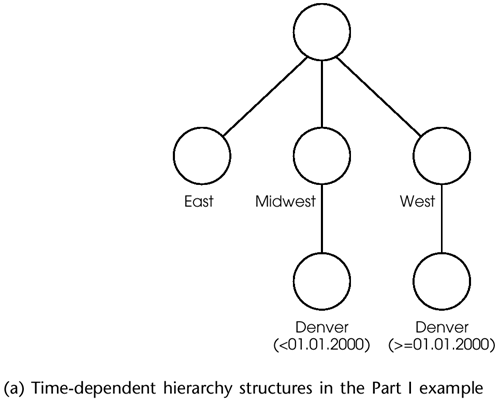

As shown in Figure 7.4(a), time-dependent hierarchy structures consist of nodes or leaves that are time-dependent. The hierarchy itself is not time-dependent.
As shown in Figure 7.4(b), time-dependent entire hierarchies consist of nodes or leaves that are not time-dependent. The hierarchy itself is time-dependent.
The following steps explain how to build the design for our example with time-dependent entire hierarchies.
Work Instructions
Step 1. Create a new IO_SREP, called IO_SREPN3. Select the Entire hierarchy is time-dependent option.
SCREEN 7.29

Step 2. Select Create hierarchy from the InfoObject menu.
SCREEN 7.30

Step 3. Specify the valid dates, and then click  to continue.
to continue.
SCREEN 7.31
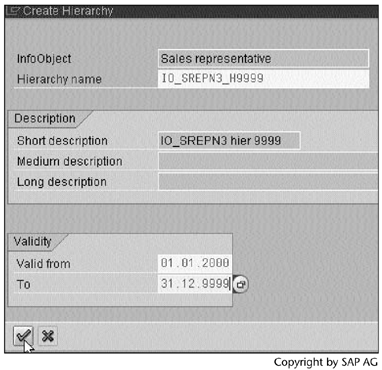
Step 4. Using the procedure given in Section 3.6.2, create a hierarchy. Notice that the Denver office is placed in the West region.
SCREEN 7.32
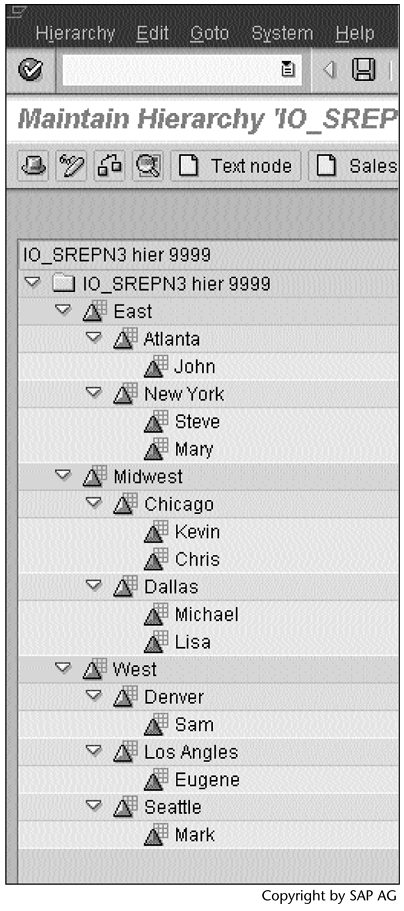
Step 5. Create another hierarchy, and specify its valid dates as being from 01.01.1000 to 31.12.1999. Now the Denver office appears in the Midwest region.
SCREEN 7.33
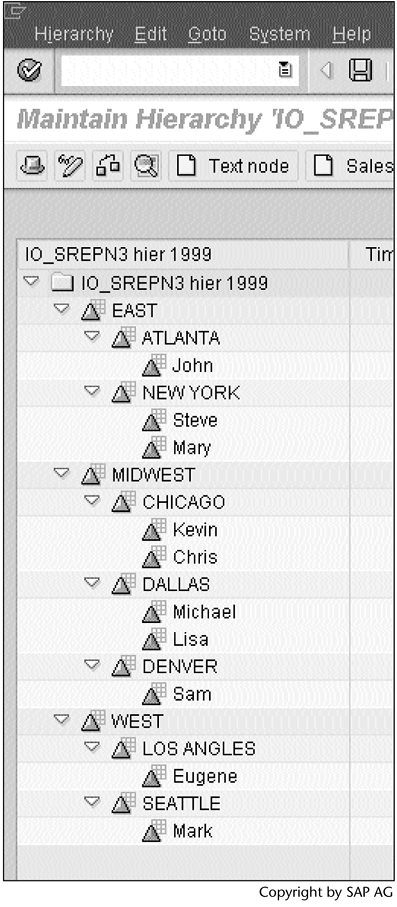
Step 6. Notice the two hierarchies. Each has an associated valid date.
SCREEN 7.34
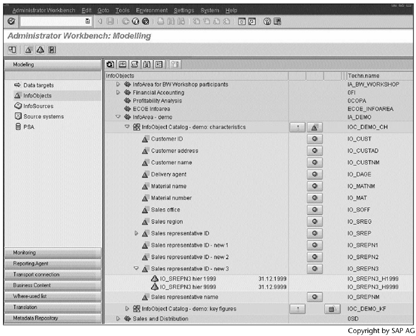
Step 7. Follow the procedure in Chapter 2 to create a new InfoCube, IC_NEWBC3.
Follow the procedure in Chapter 5 to create a new query, IC_NEWBC3_Q01. When selecting hierarchies, we have two hierarchies, not just one as shown in Screen 5.10.
Select one hierarchy, and click  . Save and run the query.
. Save and run the query.
SCREEN 7.35
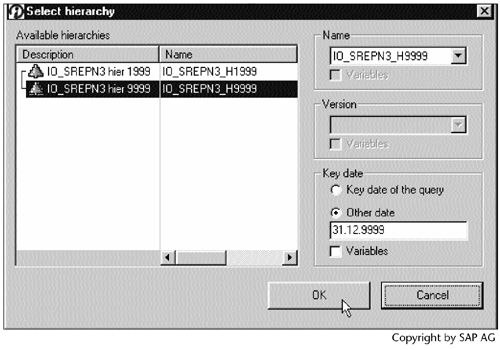
Result
The first query result shows that the Denver office is located in the West region (Screen 7.36).
SCREEN 7.36
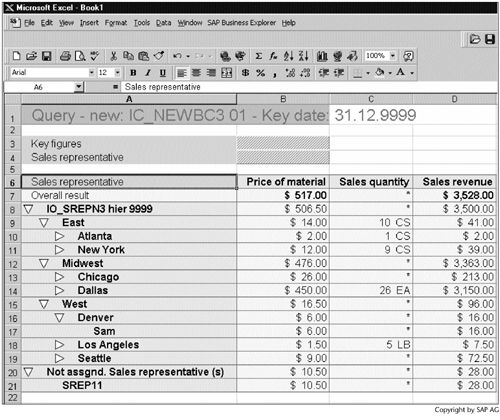
Create another query. This time, select IO_SREPN3_H1999 as the hierarchy (not IO_SREPN3_H9999, as shown in Screen 7.35). The result of this query puts the Denver office in the Midwest region (Screen 7.37).
SCREEN 7.37
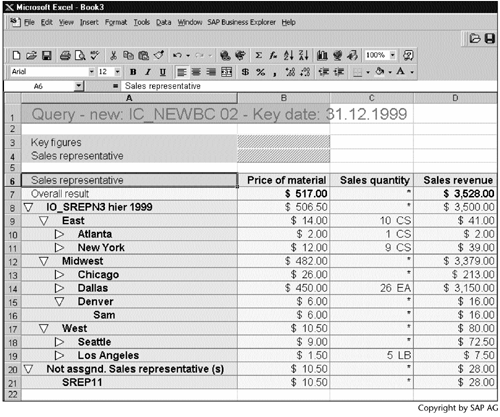
Note
The time-dependent hierarchy structure in the Section 3.6.2 design and the time-dependent entire hierarchies in the new design created in Section 7.4 produce the same query results (see Screens 5.14, 5.15, 7.36, and 7.37).
BW hierarchies are very flexible. We can easily add or delete nodes and leaves. Likewise, we can alter the number of levels.
If the hierarchy does not change very often and is not very large, then this new design is a good one. Note, however, that its performance is not as good as that of the Alternative II InfoCube design. We can create aggregates that compensate for the loss in performance to a certain extent.
Part I. Guided Tours
Business Scenario and SAP BW
- Business Scenario and SAP BW
- Sales Analysis A Business Scenario
- Basic Concept of Data Warehousing
- BW An SAP Data Warehousing Solution
- Summary
Creating an InfoCube
- Creating an InfoCube
- Creating an InfoArea
- Creating InfoObject Catalogs
- Creating InfoObjects Characteristics
- Creating InfoObjects Key Figures
- Creating an InfoCube
- Summary
Loading Data into the InfoCube
- Loading Data into the InfoCube
- Creating a Source System
- Creating an Application Component
- Creating an InfoSource for Characteristic Data
- Creating InfoPackages to Load Characteristic Data
- Checking Loaded Characteristic Data
- Entering the Master Data, Text, and Hierarchy Manually
- Creating an InfoSource for Transaction Data
- Creating Update Rules for the InfoCube
- Create an InfoPackage to Load Transaction Data
- Summary
Checking Data Quality
- Checking Data Quality
- Checking InfoCube Contents
- Using BW Monitor
- Using the Persistent Staging Area (PSA)
- Summary
Creating Queries and Workbooks
- Creating Queries and Workbooks
- Creating a Query Using BEx Analyzer
- Organizing Workbooks Using BEx Browser
- Using a Variable to Access a Hierarchy Node Directly
- Summary
Managing User Authorization
- Managing User Authorization
- Creating an Authorization Profile Using Profile Generator
- Creating an Authorization Object to Control User Access to the InfoCube Data
- Integrating Profile Generator and BEx Browser
- Summary
Part II. Advanced Topics
InfoCube Design
- InfoCube Design
- BW Star Schema
- InfoCube Design Alternative I Time-Dependent Navigational Attributes
- InfoCube Design Alternative II-Dimension Characteristics
- InfoCube Design Alternative III Time-Dependent Entire Hierarchies
- Other InfoCube Design Techniques
- Summary
Aggregates and Multi-Cubes
Operational Data Store (ODS)
- Operational Data Store (ODS)
- Creating an ODS Object
- Preparing to Load Data into the ODS Object, Then into an InfoCube
- Loading Data into the ODS Object
- Loading Data into the InfoCube
- Using 0RECORDMODE for Delta Load
- Summary
Business Content
- Business Content
- Creating an R/3 Source System
- Transferring R/3 Global Settings
- Replicating R/3 DataSources
- Installing Business Content Objects and Loading R/3 Data
- Summary
Generic R/3 Data Extraction
- Generic R/3 Data Extraction
- Creating Views in R/3
- Creating DataSources in R/3 and Replicating Them to BW
- Creating a Characteristic in BW
- Loading Data from R/3 into BW
- Summary
Data Maintenance
Performance Tuning
- Performance Tuning
- BW Statistics
- System Administration Assistant
- Tuning Query Performance
- Tuning Load Performance
- Summary
Object Transport
Appendix A. BW Implementation Methodology
Object Transport
Appendix B. SAP Basis Overview
Object Transport
- Object Transport
- Section B.1. SAP Basis 3-Tier Architecture
- Section B.2. Dispatcher, Work Processes, and Services
- Section B.3. Memory Management
Appendix C. Glossary
Appendix D. Bibliography
EAN: N/A
Pages: 106
